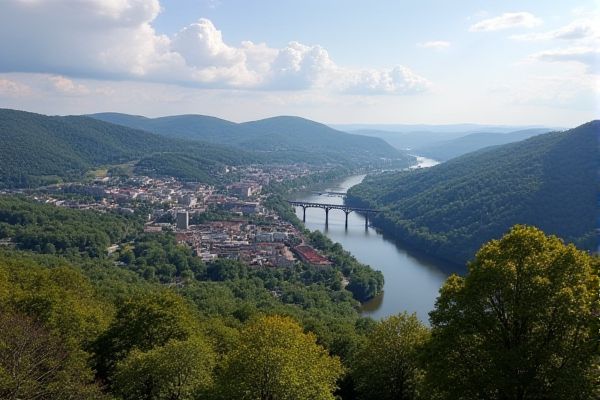
What to know as new resident in Pennsylvania: Weather patterns and seasonal changes. Local tax rates and regulations. State-specific driving laws. School districts and educational options. Popular local events and festivals. Public transportation options. Key employment sectors and job market. Housing market trends. Healthcare facilities and insurance options. Cultural norms and local etiquette.
Weather patterns and seasonal changes.
Pennsylvania experiences four distinct seasons: autumn with vibrant leaf changes in October, winter with variable snowfall and cold temperatures from December to February, spring with warming temperatures and occasional tornadoes from March to May, and summer with hot and humid conditions, especially in the southeast, from June to August. The state's weather is unpredictable, with significant regional variations in temperature and precipitation. Discover more about the state's fascinating weather patterns at the Pennsylvania Weather guide online.
Local tax rates and regulations.
As a new resident in Pennsylvania, you need to understand that the state has a flat individual income tax rate of 3.07%, but local income taxes vary by municipality, with some areas like Philadelphia levying an additional 3.75% local income tax. You must file a local earned income tax return by April 15th, and if you moved during the year, you need to account for taxes in each respective municipality using the Part-Year Resident Schedule.
State-specific driving laws.
As a new resident in Pennsylvania, you must obtain a Pennsylvania driver's license within 60 days if you hold a valid license from another state. If your out-of-state license is expired or you do not possess it, you must apply for a PA Learner's Permit and pass the vision, knowledge, and road tests. For more detailed information, you can refer to the Pennsylvania Department of Transportation guidelines to ensure you meet all requirements and deadlines for obtaining your new driver's license.
School districts and educational options.
In Pennsylvania, families have various educational options, including traditional public schools, public charter schools, public magnet schools, private schools, online learning, and homeschooling. Traditional public schools are operated by districts and are free, while magnet schools offer specialized learning tracks, and private schools provide unique environments often with tuition-based enrollment. The state also offers several free online learning options and scholarship programs for private school choice. For more detailed information, you can visit the website dedicated to Pennsylvania School Choice.
Popular local events and festivals.
Pennsylvania's Great Outdoors region and other areas host a variety of events year-round, including living history reenactments, community festivals, food and wine events, and cultural activities, each reflecting the unique character of the local towns and communities. For more information, visit the VisitPAGO website to explore a diverse range of activities that truly showcase the vibrant spirit of the region.
Public transportation options.
In Pennsylvania, public transportation is widely available, including fixed-route transit services in Philadelphia, Pittsburgh, and other urban and rural areas, shared-ride services in all counties, intercity bus routes, and Amtrak services. The state also offers accessible transportation options for seniors and persons with disabilities, including reduced fares and specialized programs like the Persons with Disabilities (PwD) Program.
Key employment sectors and job market.
In Pennsylvania, key employment sectors include Health Care and Social Assistance, which has consistently driven employment growth, adding numerous jobs between 2001 and 2019. Other significant sectors include Education and Health Services, Accommodation and Food Services, and Transportation and Warehousing, which have also seen substantial job increases. For a comprehensive analysis of these trends, visit the Pennsylvania Economic Trends Report to understand how these industries shape the state's employment landscape.
Housing market trends.
In Pennsylvania, the housing market is characterized by a competitive environment with an 8.4% increase in housing inventory, a median home price of $307,300 rising at 5.4% year-over-year, and homes spending only 26 days on the market. Despite rising prices, the market is expected to see some price corrections due to the NAR settlement, and mortgage rates around 6.25% to 6.62% are favorable for buyers. For more detailed insights and updates, you can visit the Pennsylvania Real Estate Market.
Healthcare facilities and insurance options.
As a new resident in Pennsylvania, you can access comprehensive healthcare through Medicaid (Medical Assistance), which covers physical and behavioral health services, including doctor visits, preventive care, mental health treatment, and long-term supports. You can also explore other insurance options like HealthChoices managed care, Pennie™ health and dental insurance marketplace, and various supplemental insurance plans.
Cultural norms and local etiquette.
As a new resident in Pennsylvania, it's important to understand that cultural norms are deeply rooted in the state's diverse immigrant communities. Migrants often form tight-knit communities that preserve their languages, customs, foods, and traditions, and over time, these cultures blend with American culture, creating a rich and diverse societal fabric. For further details on this evolving cultural landscape, you can explore resources provided by the Johnstown Area Heritage Association, which offers insights into the historical and contemporary aspects of these diverse communities. This blending of cultures not only enriches the social experience but also strengthens the communal ties within the state.
